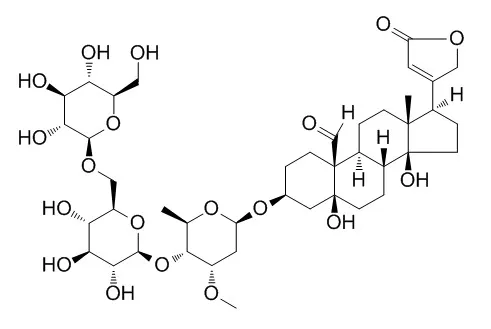| In vitro: |
| Journal of Chemical Ecology, 1994, 20(5):1039-1051. | | Cardenolides as oviposition deterrents to twoPieris species: Structure-activity relationships.[Reference: WebLink] | Oviposition responses ofPieris rapae andP. napi oleracea to 18 cardenolides were compared under the same conditions.
Effects of different concentrations of selected cardenolides were also tested.
METHODS AND RESULTS:
Most of the compounds were deterrent to oviposition by both insects, but to significantly different degrees.P. rapae were strongly deterred by k-Strophanthoside, K-strophanthin-β, cymarin, convallatoxin, oleandrin, erysimoside, erychroside, and gitoxigenin. The most deterrent compounds forP. napi oleracea were erychroside, cymarin, erysimoside, convallatoxin, and k-Strophanthoside. Strophanthidin-based glycosides were more deterrent than digitoxigenin-based ones, and the number and type of sugar substitutions can have profound effects on activity. Both similarities and contrasts were found in responses of P. rapae andP. napi oleracea to these cardenolides.
CONCLUSIONS:
Cymarin was equally deterrent to bothPieris species at all concentrations tested. However, when compared withP. rapae, P. napi oleracea was less sensitive to most of the cardenolides.P. napi oleracea was insensitive to K-strophanthin-β and oleandrin at 0.5 × 10(-4) M, which were highly deterrent toP. rapae. |
|
| In vivo: |
| Arzneimittel Forschung, 1979, 29(5):827-829. | | Cardiomechanical effect of k-strophanthoside administered to healthy volunteers by the rectal route.[Reference: WebLink] | Eight healthy volunteers were given k-Strophanthoside (Strofopan) 1 mg rectally in order to evaluate changes in the cardiac function.
METHODS AND RESULTS:
Cardiomechanical measurements were performed by the polygraphic method before administering the drug and 1, 2, 3, 4, 5 and 6 h later. Three of the eight subjects continued to receive k-Strophanthoside 1 mg daily for a further 6 days. Similar evaluations were made at the same times on day 3 and on day 7 of treatment. All indices considered varied to a statistically significant extent and showed the maximum effect at about the 4th h. The most evident changes were observed in the ICT and the PEP/LVET ratio. Here, the maximum variations were 46.3% and 29.5%, respectively, as compared with baseline values (P less than 0.01). When treatment was given for 7 days, the baseline values measured on day 3 and day 7 before administration showed a moderate and constant decrease in all parameters as compared with the first baseline value.
CONCLUSIONS:
This proves that k-Strophanthoside administered rectally possesses steady-state activity with time.From a comparison of the changes in the same parameters as observed in a previous investigation after administering digoxin 0.50 mg orally there is reason to conclude that the effects obtained after administering k-Strophanthoside 1 mg rectally were of the same magnitude. |
|






 Cell. 2018 Jan 11;172(1-2):249-261.e12. doi: 10.1016/j.cell.2017.12.019.IF=36.216(2019)
Cell. 2018 Jan 11;172(1-2):249-261.e12. doi: 10.1016/j.cell.2017.12.019.IF=36.216(2019) Cell Metab. 2020 Mar 3;31(3):534-548.e5. doi: 10.1016/j.cmet.2020.01.002.IF=22.415(2019)
Cell Metab. 2020 Mar 3;31(3):534-548.e5. doi: 10.1016/j.cmet.2020.01.002.IF=22.415(2019) Mol Cell. 2017 Nov 16;68(4):673-685.e6. doi: 10.1016/j.molcel.2017.10.022.IF=14.548(2019)
Mol Cell. 2017 Nov 16;68(4):673-685.e6. doi: 10.1016/j.molcel.2017.10.022.IF=14.548(2019)